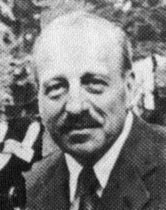
Dr. Giorgos Papanicolaou (1883-1962)

He developed the famous "Test-Pap" named after him for cervical cancer.
A biography
George N. Papanicolaou, MD, the originator of the "Pap test," was born in Coumi,
Greece, in 1883. He received his medical degree from the University of Athens in 1904 and,
after serving in the Greek army, joined his father's medical practice for a year. Then,
against his father's advice, the younger Dr Papanicolaou embarked upon an academic career,
earning a PhD in zoology from the University of Munich in 1910.
In 1913, Dr. Papanicolaou arrived in America with Mary, his new wife and lifelong research
associate, becoming an assistant and research biologist under Charles R. Stockard, MD, at
Cornell Medical College, where he was to stay for 47 years. Drs. Stockard and Papanicolaou
studied the role of chromosomes in sex determination, and Dr. Papanicolaou noticed
recurring cytological changes over a 15 to16-day cycle, in the vaginal discharge of the
guinea pig. By correlating these changes with the ovarian and uterine cycles, the
scientists described a technique that in time became standard for measuring the sexual
cycles in a variety of species.
Applying his theory to humans, Dr. Papanicolaou began observing vaginal smear changes in
1923, discovering that women with uterine cancer exhibited "abnormal cells, with
enlarged, deformed, or hyperchromatic nuclei." He termed it, "One of the most
thrilling experiences in my scientific career," but the scientific community
considered Dr. Papanicolaou's technique an unnecessary addition to existing uterine cancer
diagnosis.
Dr. Papanicolaou joined Herbert F. Traut, a gynecologist who appreciated the importance of
his research, in 1939 and they published "Diagnosis of Uterine Cancer by the Vaginal
Smear," in 1943. It showed how lesions could be detected in their incipient,
preinvasive phase and was a turning point in management of cervical cancer, the most
deadly form of cancer in women at the time. The Pap smear test soon became widely accepted
as a routine screening technique and in two decades, cervical cancer went from first to
third most deadly form of cancer. In the following years, Dr. Papanicolaou extended his
technique to the respiratory, urinary, and upper gastrointestinal tracts and the breast.
His method has been used to screen for cancer in many organs and to predict cancer
radiosensitivity and evaluate the efficacy of radiotherapy.
Exfoliated cytology, and "Dr. Pap," attracted worldwide attention. Honors and
invitations came from numerous institutions and organizations -- including the American
Society of Clinical Pathologists, which invited him to present the opening paper for a
symposium on "Cytologic Diagnosis of Cancer" at the twenty-seventh annual
meeting in 1948. He became an honorary ASCP Fellow in 1956.
Throughout his career Dr. Papanicolaou's work habits and character remained constant. A
devoted scientist, he worked six or seven days a week with no vacations for years. He
operated with great care and thoroughness, which may have contributed to a somewhat trying
secretive streak. Yet he remained a courtly man who treated his achievements lightly,
"I often feel that whatever I have accomplished has been largely a matter of good
luck." Although Dr. Papanicolaou was not a very enthusiastic teacher, he was proud of
his Atlas of Exfoliative Cytology, a textbook that was published in 1954 with supplements
in 1957 and 1960.
Toward the end of his life he dreamed of an institute for exfoliative cytology, desiring a
less constrained research environment where future scientists and technicians could be
trained. In 1961 he became director of the Papanicolaou Cancer Research Institute in
Miami; but the dream was short-lived. Months after moving to Florida, on February 19,
1962, Dr. Papanicolaou died of a heart attack at age 79.
Our additional comments:
He received 53 various awards, his face was put on two stamps (Greece and USA)
and on the banknote of 10,000 Greek drachmas. When, in 1928, he published one
paper "New detection of cancer", he was being treated as
'story-teller' by the medical nomenclature of that time. However, the newspaper
"New York World" thought that, even that his paper could not predict
how useful his method would be, cancer would have to be dealt with, in its
earlier stages, and so a possible cure would, anyway, become easier. In 1912,
while working in Paris, the first world war broke out and he returned to Greece
with his wife to fight for his country's. He met some Greek-Americans there, who
suggested him to go to America, which he did the following year.
Other links:
Fundación George N. Papanicolaou a
medical foundation after the name of Dr Papanicolaou in Argentina
George Papanicolaou, MD - Pathology
Pioneers from ASCP
Papanicolaou Woman's
Corps for Cancer Research with over 8000 members fundraised so far 11m$ for cacner
United States Postage Stamps 1971-80
a US stamp with the face of Dr Papanicolaou
GCS - Great Canadian Scientists a Canadian award after the name
of Dr Papanicolaou. Look into the names
Pap test informatin on the test
His face and name appears on 10,000 Greek Drachma banknotes
Papanicolaou Smear
And Cervical Cancer information on cervical cancer
The CyberMom Dot Com - Medicine Chest
medical information
CAP Public Interest - Dr. Pap
Papanicolaou, George N.
Papanicolaou information about him
from Mexico
Pap Smear or Pap Test for Patients
b?squeda bibliografica salud reproduc
abril'98
A huge hospital is named after him in Thessaloniki, Greece (no link available)